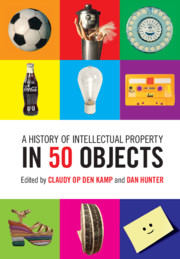Book contents
- Frontmatter
- Dedication
- Contents
- Acknowledgments
- Introduction: Of People, Places, and Parlance
- The Pre-Modern Period
- The Age of invention
- Modern Times
- The Consumption Age
- 26 Bell Transistor
- 27 Oral Contraceptive Pill
- 28 Photocopier
- 29 Elstar Apple
- 30 Chanel 2.55
- 31 Lego Brick
- 32 Barbie Doll
- 33 Coca-Cola Bottle
- 34 Zapruder Film
- 35 Audiotape Cassette
- 36 Action Figure
- 37 RAM-Chip
- 38 Football
- The Digital Now
- About The Contributors
33 - Coca-Cola Bottle
from The Consumption Age
Published online by Cambridge University Press: 12 June 2019
- Frontmatter
- Dedication
- Contents
- Acknowledgments
- Introduction: Of People, Places, and Parlance
- The Pre-Modern Period
- The Age of invention
- Modern Times
- The Consumption Age
- 26 Bell Transistor
- 27 Oral Contraceptive Pill
- 28 Photocopier
- 29 Elstar Apple
- 30 Chanel 2.55
- 31 Lego Brick
- 32 Barbie Doll
- 33 Coca-Cola Bottle
- 34 Zapruder Film
- 35 Audiotape Cassette
- 36 Action Figure
- 37 RAM-Chip
- 38 Football
- The Digital Now
- About The Contributors
Summary
JUST OVER A century ago, The Coca-Cola Company faced a major challenge. Copycat colas with similar names and bottle designs—Noka-Cola, Coke-Ola, and the like—openly free-rode on the popularity of the fizzy drink. In 1915 it devised a potent tool to deter knockoffs: the distinctive delivery system that we know today as the Coca-Cola bottle.
A unique bottle, the Company hoped. would serve as a versatile and powerful anti-fraud device. If the company's bottlers used only this bottle, and only Coca-Cola was sold in the bottle, consumers could know exactly what they were getting. The company could sue any competitor that dared to use a similar (much less identical) bottle. Better yet, the cost and risk of development might be too great for a knockoff to even attempt.
Today the famous curvy bottle is ubiquitous and synonymous with the product itself. Yet, the whole notion of bottling was actually an afterthought for the company. Early ads showed only fountain Coca-Cola. Company founder Asa Candler thought bottles were low-class and left the bottling task to others, even going so far as to enter into a perpetual contract for syrup at a set price because he was so dubious of the enterprise. Syrup was sold to bottling franchisees all over the country. Candler miscalculated, as bottle sales soon outpaced fountain sales. Even Americans who would never find themselves seated at the soda fountain could buy a bottle of Coca-Cola for a nickel. While Candler's decision left huge profits on the table, it had the happy side effect of encouraging entrepreneurs to spread the Coca-Cola gospel. Bottling turned out be a force for consumer diversification and mass consumption.
The company needed the bottlers’ cooperation and investment to make any switch to a new uniform bottle. Yet bottlers were an unlikely partner in the quest to stamp out free-riders. Early bottles could be any shape or color, required by contract merely to have diamond-shaped paper labels bearing the company's name in capital letters. As agents of the company, some bottlers were faithless in the early days, furtively adulterating the syrup with saccharine.
- Type
- Chapter
- Information
- A History of Intellectual Property in 50 Objects , pp. 272 - 279Publisher: Cambridge University PressPrint publication year: 2019

